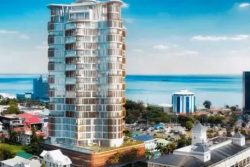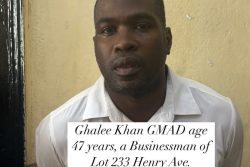The Vandals have been a bit unfortunate in history; they have lent their name to gratuitous and purposeless destruction. It is not that they could be exonerated completely from the charge, it is more that they had contemporaries like the Ostro-Goths and Visi-Goths, for example, who were no less partial to pillaging the Roman Empire when the opportunity presented itself than they were. The Vandals acquired their odious reputation, it is said, because they sacked Rome in 455 ad, and on account of their efforts there, their name was associated with the destruction of monuments and works of art in particular. It was in this narrower meaning that the term ‘vandalism’ was first employed, passing into English, it is said, shortly after the Bishop of Blois (either in 1793 or 1794 – no one seems too sure) coined the word vandalisme in French, to describe the depredations visited on art works during the French Revolution.
Well Guyana has its own history of vandalisme in the original sense, as opposed to its modern connotations. In addition, Guyana has created its very own variation on the theme. We do not always actively destroy. With the aid of a humid tropical climate and an army of variegated insects, we can leave our historical buildings and monuments (and documents) to moulder away without interference – albeit sometimes with help from ordinary modern-day vandals – until they expeditiously crumble into dust. That is exactly what happened in the case of the New Amsterdam Hospital, for example, a fate made worse by the fact that we were all lulled into a state of security because Minister Ramsammy kept making placatory noises about various plans the government had for the building. It was all a bluff.
There is no bluffing, however, in the case of another historical monument; on this occasion a very direct approach is being adopted. This is the Bourda Cemetery, the only plantation cemetery which survives (barely) in the city, and certainly one of the very, very few still in existence in the country. Never mind that the site is on the National Trust list of monuments, the powers-that-be of one variety or another have had the destruction of this graveyard in mind for a very long time. The first serious attempt was made in 1960, when H R Persaud and the Historical Society lobbied to save it, which ultimately they succeeded in doing, although not before some serious damage had already been inflicted. Then the issue raised its head again in 1982, 1992, 1995, 1996, 1999, 2001 and 2004.
What has stymied all efforts at obliterating the site since 1992 is that in that year, the Guyana Heritage Society took the Mayor and City Council to court and secured an injunction preventing them from embarking on road construction in the cemetery. The fact that various officials and one international financial institution could put forward proposals on five separate occasions thereafter, completely oblivious of the court injunction, speaks volumes about the continuity of administrative decision-making in this country. In addition to a road, there were proposals for a site for vendors, a shopping mall and a garden – the last mentioned being the least problematic since potentially, at least, it could have been made compatible with the survival of the graveyard.
This time around, however, the authorities have finally adjusted to the reality that there is a court injunction which prevents them from proceeding at whim, although they have indicated that they believe they have found a way around it. They did not divulge what that was, but in fact, the only obvious way around the legal impediment is if the government goes to the National Assembly to change the law, because Bourda Cemetery is governed by act of parliament – in the first instance by Ordinance No 2 of 1876 and subsequent to that, Ordinance No 22 of 1896. The Mayor and City Council does not own this particular burial ground, but under the statutes it does have custodial responsibilities in relation to it, and as everyone knows it has not discharged these for decades. Ms Mavis Benn was the last mayor to make any attempt to fulfil the M&CC’s legal obligations in this regard.
Having allowed many of the surviving tombs to be seriously damaged by a vandalism of neglect (ably assisted admittedly, by the despoliation efforts of more than one generation of vagrants) some mayors, including the current one, have argued for the extirpation of the cemetery. Needless to say, the M&CC is involved in the current vandalisme project, which resuscitates once again the proposal to locate vendors there. The co-conspirators on this occasion are Minister Kellawan Lall and Senior Vice-President of the Georgetown Chamber of Commerce and Industry, Mr Frank De Abreu, who met President Bharrat Jagdeo to discuss the matter recently, according to GINA. The agency quoted Mr De Abreu as saying: “I believe we should relocate it [the cemetery] as has been done all over the world… we should remove the site, make it a prime commercial area, create jobs and put vendors in a more decent place.”
One doesn’t really expect businessmen to have a great sensitivity to heritage – although there are some notable exceptions – they are generally more concerned with raw profits. There is no such excuse, however, in the case of our national authorities, who are charged with the care of our monuments not just for the benefit of this generation but also for those who come after us. What is their justification, one wonders, for huddling in a little group with the representatives of commerce and the notoriously incompetent city council to plot the final stage in the vandalising of a monument which their own National Trust has listed? And this, it might be added, without holding any public prior discussions or having recourse to the cultural authorities in this city. Is the National Trust just a showpiece? Another sham institution which allows the government to say how concerned it is about the nation’s material heritage, when the truth is that the opposite is the case?
Just what gives the GCCI too the idea that in cahoots with the authorities it has the right to instigate the elimination of the capital’s patrimony to which none of its members can claim ownership? In any case, just what is Mr De Abreu talking about? Relocate the cemetery where? Does he have it in mind just to dump whatever survives in the garbage-ridden Le Repentir, perhaps?
This is not about respect for the dead, although it might be mentioned that in this superstitious society some vendors might balk at selling their plastic wares while standing above human remains – but that is another story. It is also not about restoring the cemetery to what it once was, because that cannot be done, given the extent of the vandalism which has taken place already. It is, however, about rehabilitating the space in a way which retains its original purpose, and at the same time provides a pleasant environment and historical information for citizens, children and tourists alike.
Eons ago – in 2001, in fact – in the days when the government wanted to have Georgetown inscribed on the World Heritage List, and an expert was brought down to advise on how to proceed, the Bourda Cemetery was destined to play a role. The consultant, Dr Ron van Oers, who helped get Paramaribo on the World Heritage List, pointed out something which we all instinctively knew, but which had never been expressed in that way before, namely, that Georgetown is a plantation city, and furthermore, the only plantation city in the world. The evidence is everywhere: in its nomenclature, its grid-like structure; its streets and sites like the Bourda Cemetery. The burial ground, in fact, belonged to Plantation Vlissengen, and Regent Street was the estate’s middle walk. The coffee logie was located where City Hall now stands, while it is from Vlissengen’s former owner that the name ‘Bourda’ derives. The whole idea was to emphasise the city’s plantation heritage as part of the route to inscription, which if successful, could then have attracted funding. It might be added that with the development of a comprehensive historical and tour package visitors would have been attracted and employment created. So would the government like to say if it has now totally abandoned the plan to have Georgetown inscribed on the World Heritage List in favour of vendors’ arcades on historical sites?
This government’s recent record on the material heritage is looking worse than its predecessor’s, which was anything but good, and there is nothing to be said in the M&CC’s favour on that score either. What will save our politicians from possibly having their names expropriated in the future to describe Guyana’s version of vandalisme is that Ramsammyism or Lallism or Greenism simply do not roll off the tongue with any great felicity; one presumes that even the Bishop of Blois picked on the Vandals, because the name of the Huns or the Goths, for example, would not have supplied the same easy cadence.







